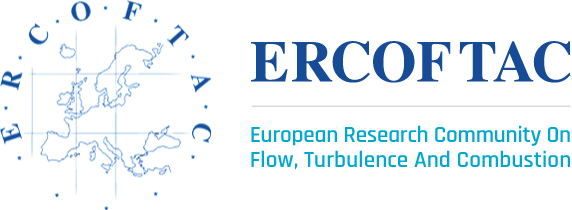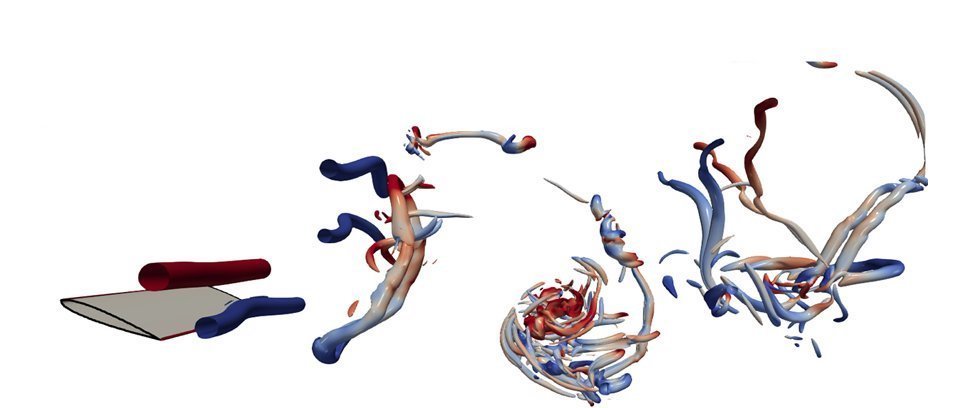Mini Symposia
Physics-compatible numerical methods for fluid flows
Organizers: F.Xavier Trias, Francesco Capuano, Artur Palha, Gennaro Coppola & Roel Verstappen
Over the last decades, Computational Fluid Dynamics (CFD) has become a standard design tool in many fields such as the automotive, aeronautical, and wind power industries. The driving force behind this trend is the continuous progress of high performance computing (HPC) systems, in conjunction with the development of increasingly advanced numerical techniques. While the solution of (quasi-)steady problems using RANS modeling has been (and still is) the standard approach in industry, major research efforts are currently being devoted towards enabling high-fidelity, eddy-resolving simulations of complex flows in reasonable turnaround times. This paradigm shift requires a wise combination of numerical robustness, physical fidelity and algorithmic efficiency, a set of conflicting requirements that has never ceased to thrill the scientific community. The flourishing class of so-called physics-compatible numerical methods, i.e. methods that aim to discretely preserve the underlying mathematical and physical structure of the continuum model, holds great promise for solving this challenge, and has recently become a major research topic at the intersection of computational science, numerical analysis and fluid flow physics. There is now strong evidence that these methods are capable of improving the physical fidelity of numerical results and providing enhanced robustness to the simulations, while keeping the computational cost at affordable levels.
The main goal of this mini-symposium is to bring together researchers working on the development and the application of cutting-edge numerical methods for fluid flows based on the physics-compatible paradigm. These include: methods with discrete conservation properties (e.g., kinetic energy, helicity, enstrophy in 2D flows, entropy, etc.), invariant-preserving algorithms for high-order schemes (e.g., discontinuous Galerkin, spectral element), physics-based shock-capturing schemes, mimetic methods, geometric time integration schemes, boundary conditions with summation-by-parts properties, entropy-stable methods, physics-inspired implicit/explicit large-eddy simulation (LES) models, among others; careful comparisons between physics-compatible and "traditional" approaches are also welcome. Despite its enormous potential benefits, the application of these methods to complex engineering problems is still rather limited. Bridging the gap between academic developments and industrial needs is the second objective of the mini-symposium, by focusing on the successful applications of such methods in the context of complex engineering or biological flows. Topics include, but are not limited to: compressible aerodynamics, multiphase flows, flow instabilities, reacting flows, bubble dynamics, natural convection, cardiovascular flows, heat and mass transfer intensification, or drag reduction, among others.
Recent advances in large eddy simulation of multiphase flows
Organizers: Mahdi Saeedipour, Jean-Luc Estivalezes & Stephane Vincent
Turbulent multiphase flows are omnipresent in many industrial applications and processes such as fuel atomization, oil transport, emulsion technology, and powerplant safety. In most of these problems, a wide spectrum of physical length and time scales are involved which could become more complex when heat transfer and chemical reactions step in. Obtaining a detailed insight into such complex multiphase physics is usually beyond the reach of experimental or analytical methods. Given the fact that direct numerical simulation (DNS) is mostly possible in academic test cases, large eddy simulation (LES) has gained a lot of attention in the past years for engineering problems. However, the LES of multiphase flows differs from the LES of single-phase flow in many fundamental aspects and has not reached an equal level of maturity. The major shortcoming originates in the different nature of the under-resolved physics which has to be properly modelled by subgrid-scale (SGS) closures.
In the past years, several contributions from the community have been published on the LES of multiphase flows in both a priori and a posteriori studies. The overarching concept of SGS modelling could be split in classical families of (i) functional, and (ii) structural models. With the recent progress in data science, a third category of (iii) data- driven SGS models has gained prominence. Nevertheless, several shortcomings, limitations and questions remain the subject of ongoing research in the community.
This mini-symposium aims to:
- provide a podium for extensive discussion and scientific exchange between the active researchers involved in this topic, particularly about shortcomings in the existing SGS models, limitations in numerical and experimental validations, and potential overlaps between the current research directions.
- outline the future research perspective in LES of multiphase flows with respect to the capabilities and limitations of developed codes and various academic benchmarks as well as relevant industrial problems.
Transition modelling
Organizers: Daniele Simoni & Slawomir Kubacki
The aim of the mini-symposium is to attract a relevant number of presentations that give to the audience an insight on the current developments in modelling of transition from laminar to turbulent flow within the methodology of RANS simulation (Reynolds Averaged Navier Stokes equations) and possibly also within the methodology of hybrid RANS/LES (combined RANS and Large Eddy Simulation). Also presentations on experimental investigation and high-fidelity numerical simulation (LES or DNS) of transitional flows are welcome when the target is identification of possible modelling ingredients or construction of a test case for transition models.
The mini-symposium on transition modelling welcomes presentations on development and testing of models for transition of laminar flow to turbulent flow. Also presentations on experimental investigation and high-fidelity numerical simulation (Large Eddy Simulation and Direct Numerical Simulation) of transitional flows are welcome when the target is identification of possible modelling ingredients or construction of a test case for transition models. Flow configurations may be internal (turbomachinery) or external (aircraft). Simulation methodologies may be RANS (Reynolds Averaged Navier Stokes equations) or hybrid RANS/LES (combined RANS and Large Eddy Simulation).
Hybrid RANS/LES methods
Organizers: Christophe Friess & Rémi Manceau
Turbulent flows are challenging to simulate. Due to its nature, turbulence involves a wide range of scales, and is very costly in terms of computational resources. The average description, provided by RANS (Reynolds-Averaged Navier Stokes) is still very popular. However, it tends to be supplanted by Large Eddy Simulation (LES), which is more accurate. This implies that LES is more costly, especially for the industrial simulation of wall-bounded flows at at high Reynolds number. As a result, hybrid RANS/LES methods have emerged over the last three decades. The main objective of these methods is to avoid the resolution of the whole domain in LES, since this approach is out of reach for most of the industrial applications, in particular due to the high computational cost associated with the near-wall region.
The proposed mini-symposium intends to offer a forum to discuss the latest advances on hybrid RANS/LES methods as well as future challenges:
- Transition between RANS and LES regions.
- Transition between laminar and turbulent regimes
- Multiphysics problems
- Mesh adapting strategies
- Data-driven modelling
- Adaptation to Lattice-Boltzmann methods.
Machine learning for turbulence
Organizers: Ricardo Vinuesa, Paola Cinnella & Christopher Rumsey
The application of machine-learning (ML) methods to fluid mechanics has experienced an exponential growth over recent years. Despite this, ML applications to fluid dynamics are still in their infancy, and the encouraging results achieved up to now have been generally restricted to academic problems characterized by simple geometries and flow physics. The availability of abundant, complete and accurate data is currently far from satisfactory in view of the deployment of ML methods to realistic flow problems. On the other hand, fine-detail understanding, accurate modeling and reliable prediction of complex flows remain significant challenges for both fundamental and applied fluid dynamics. The development of a new generation of ML-assisted methods and models for the simulation and modeling of different kinds of flows is a key enabler toward improved predictive capabilities, with impact on the design of more efficient and environmentally-friendly fluid-flow systems.
In this Symposium we aim to establish an open dialogue on these very important issues, and generate a sense of community among researchers working on data-driven methodologies for fluid mechanics, with emphasis on turbulence modeling. The development of proper benchmarking practices and configurations to define the state of the art in ML methods for fluid mechanics will also be an important aspect of this Symposium. Some of the topics included in this Symposium are:
- Data-driven/data-augmented models for different physical phenomena in fluid dynamics, e.g., turbulence modeling.
- ML-assisted reduced-order modeling or surrogate modeling of fluid flows, feature detection, signal processing, etc.
- ML-based flow-control and optimization.
- Super-resolution reconstruction of flowfields, data assimilation and sensing in experimental setups.
- Quantification of model uncertainties, with emphasis on machine-learning-based models.
High-fidelity simulations of industrial flows
Organizers: Maria Vittoria Salvetti & Stefan Hickel
Turbulence-resolving numerical simulations, like large-eddy simulations (LES) and direct numerical simulations (DNS), can provide a reliable and detailed description of turbulent flows by eliminating or reducing turbulence modeling errors. On the other hand, these simulations require huge computational resources, and, consequently, they are typically limited to simple academic flows. However, the growth in computer power and facilities makes possible nowadays to perform high-fidelity LES and DNS simulations for industrial relevant flow configurations. This opens exciting new avenues towards understanding, predicting, and modeling turbulent complex flows.
The goal of the mini symposium is to establish the state-of-the-art on the generation of high-fidelity databases of complex flows of industrial interest by means of turbulence resolving numerical simulations. The topics featured by the mini symposium are:
- assessment and analysis of the results of high-fidelity simulations of complex turbulent flows
- use of high-fidelity data for the assessment and improvement of low-fidelity approaches
- near-wall and closure modeling in large-eddy simulations
- numerical methods for high-fidelity simulations.
Towards climate neutral thermochemical energy conversion
Organizers: Markus Klein, Christian Trapp & Benjamin Böhm
The transformation of the transport sector into a climate-neutral economy is particularly challenging, because for some applications there are only few alternatives to high energy density liquid fuels. Therefore conventional or new concepts for thermochemical energy conversion in combination with e-fuels will play an important role during the transition phase towards a future, carbon-free energy landscape and even beyond that. The need for new biogenic, synthetic, carbon free or carbon reduced fuels together with the development of new combustion concepts poses considerable challenges to the research community. The design and development of new combustion systems requires extensive multi-scale and multi-physics experimental and numerical analysis.
In the recent years, several contributions from the community have been published dealing with fundamental aspects of high fidelity modelling and experimental characterization of internal combustion engines. The urgent need for the use of carbon free fuels such as hydrogen or ammonia or e-fuels like methanol, DME or ethanol requires tremendous research efforts because all these fuels have largely different thermo-chemical properties, different flame speeds, flame temperatures and flammability limits and are sometimes difficult in terms of emission control. In addition to this, there is the need to make thermochemical energy conversion more efficient using concepts like RCCI or water injection using two injectors or fuel/water emulsions in combination with carbon free or synthetic energy careers. This mini-symposium aims at contributing to fundamental physical understanding and high fidelity modelling of turbulent combustion using alternative fuels and new energy conversion concepts. It brings together specialists with analytical, experimental and numerical background with different perspectives to the topic. It will give participants the possibility to present and discuss their work and to initiate and intensify collaborations in this field.



